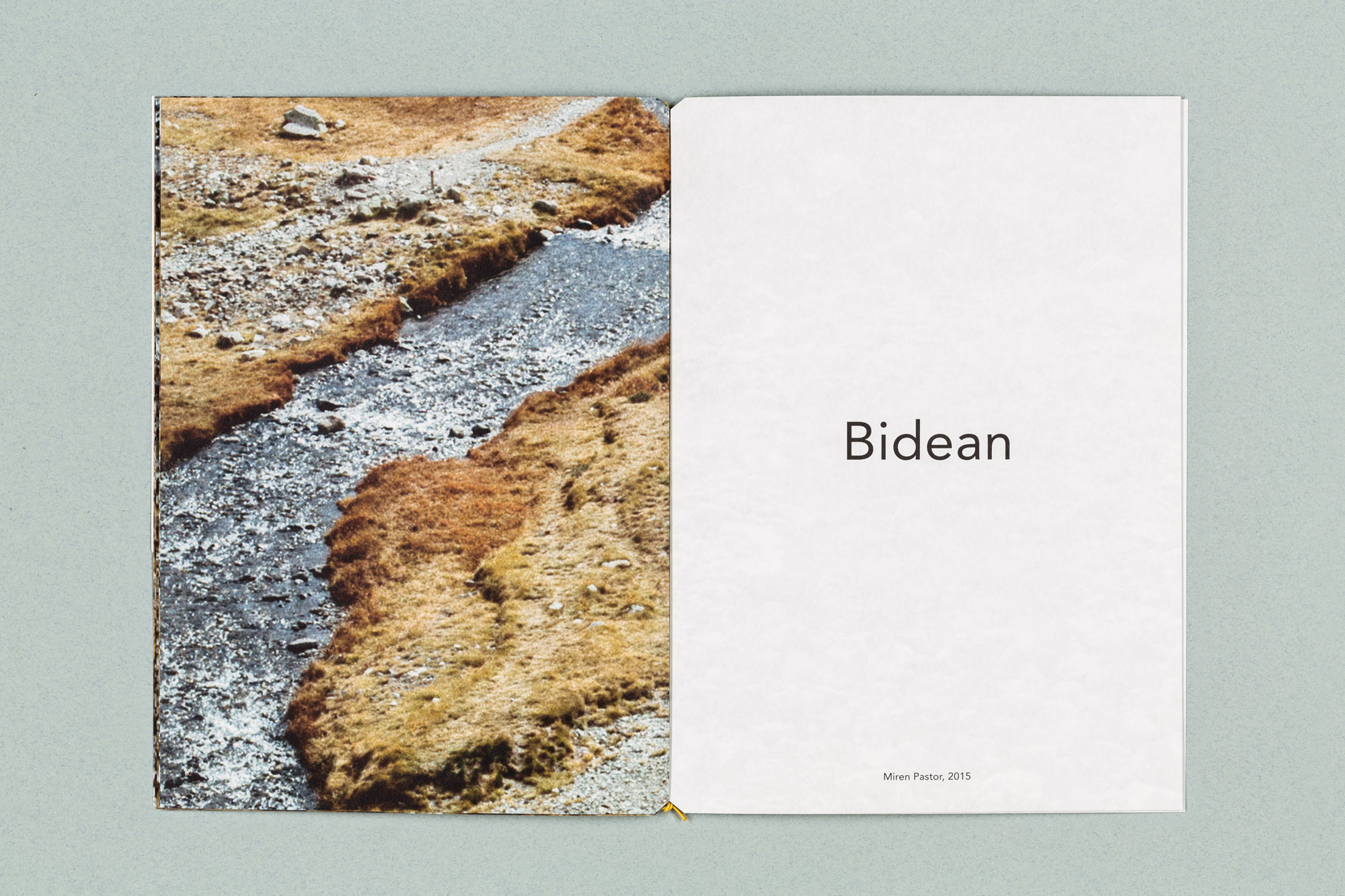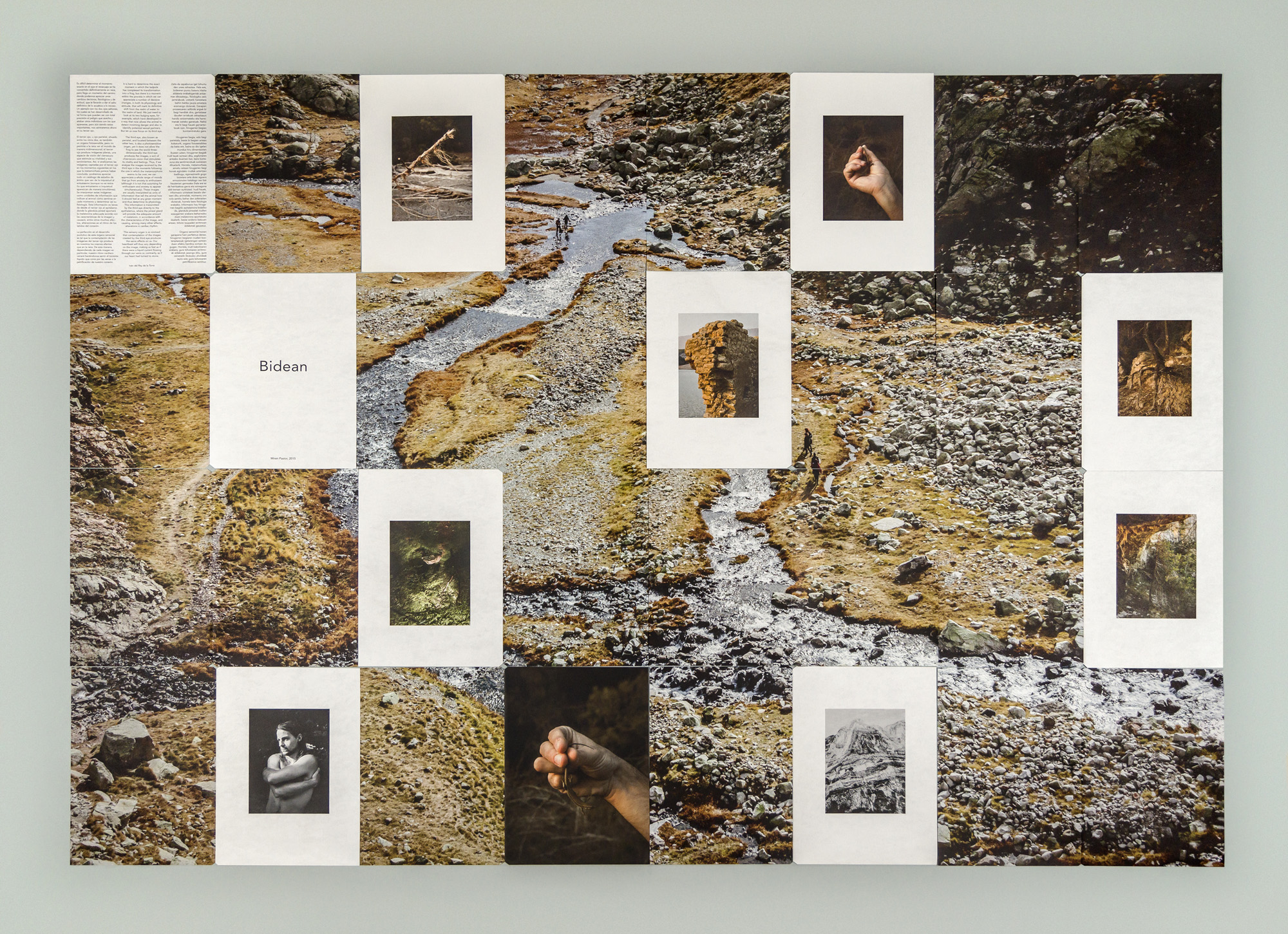Bidean 2015












Bidean 2015
ISBN 978-84-606-7330-9
Self-published, 2015
Editing: Miren Pastor, Víctor Garrido, Gonzalo Romero, Alberto Salván
Design: Tres Tipos Gráfico
Prepress: Víctor Garrido (La Troupe)
Printing: Artes Gráficas Palermo
Binding: Isabel Zambelli y Fani Samper
Text: Iván del Rey de la Torre
32 pages
17 x 23,5 cm
Edition of 500 numbered copies
Last items!
Bidean 2015
Bidean is a Basque word that refers to something or someone that is in the process of or on the path to; it symbolises the transition from adolescence to adulthood, searching for parallels between the ephemeral stages of life and the unstable cycles of nature.
These three self-published works are a fundamental tool used to structure this ongoing project and they fulfill a dual purpose: they are both books and exhibition resources. If you unbind them and follow the coordinates shown on each page, a representative mosaic of each stage appears, including a text by Iván del Rey de la Torre:
It is hard to determine the exact moment in which the tadpole has completed its transformation into a frog, but there is a moment within the process in which we can appreciate a number of decisive changes, in both its physiology and attitude, that will mark its definitive shift from the realm of water to the realm of land. We just need to look at its two bulging eyes, for example, which have developed in a way that now allows the animal to detect incoming danger and also to identify potential sexual partners. But let us now focus on its third eye.
The third eye, also known as parietal, and located between the other two, is also a photosensitive organ, yet it does not allow the frog to see the world three-dimensionally; the third eye produces flat images, a sort of chiaroscuro vision that stimulates its vitality and feelings. Thus, if we analyse the images received by the third eye in the moments following the one in which the metamorphosis seems to be over, we can appreciate a whole range of moods that go from anxiety to enthusiasm (although it is not that surprising for enthusiasm and anxiety to appear simultaneously). These images are usually interpreted as units of information that tell the animal how it should feel at any given moment and thus determine its physiology. This information is transmitted by the third eye directly to the epithalamus, where the pineal gland will provide the adequate amount of melatonin, in accordance with the characteristics of the image, and causing, among many other effects, alterations in cardiac rhythm.
This sensory organ is so evolved that contemplation of the images created by the third eye produces the same effects on us. Our heartbeat will thus vary depending on the image, making us feel as if there were a liquid current flowing through our veins or, contrarily, as if our heart had turned to stone.
Bidean, que en euskera significa que algo o alguien está en el proceso o en el camino, representa el salto de la adolescencia a la vida adulta, buscando paralelismos entre las efímeras etapas vitales y los ciclos inestables de la naturaleza.
Las tres autopublicaciones se han convertido en una herramienta clave para estructurar este proyecto río que sigue creciendo y cumplen una doble función, como libro y como recurso expositivo. Al desencuadernarlas y seguir las coordenadas indicadas en cada página, surge un mosaico representativo de cada etapa, acompañado de un texto de Iván del Rey de la Torre:
Es difícil determinar el momento exacto en el que el renacuajo se ha convertido definitivamente en rana, pero llega un momento del camino donde podemos apreciar unos cambios decisivos, fisiológicos y de actitud, que le llevarán a dar el salto definitivo de lo acuático a lo rocoso. Un ejemplo son los dos ojos saltones, los cuales se han desarrollado de tal forma que pueden ver con total precisión el peligro que acecha y atisbar otros individuos con los que aparearse, pero aún siendo estos importantes, nos centraremos ahora en su tercer ojo.
El tercer ojo, u ojo parietal, situado entre los otros dos, es también un órgano fotosensible, pero no permite a la rana ver el mundo de manera tridimensional; el tercer ojo produce imágenes planas, una especie de visión del claroscuro que estimula su vitalidad y sus sentimientos. Así, si analizamos las imágenes captadas por el tercer ojo en los momentos siguientes en los que la metamorfosis parece haber concluido, podremos apreciar todo un catálogo de estados de ánimo que van de la inquietud al entusiasmo (aunque no es extraño que entusiasmo e inquietud aparezcan de manera simultánea). Se interpretan estas imágenes como unidades de información que indican al animal cómo sentirse en cada momento y determinar así su fisiología. Esta información es lanzada desde el tercer ojo al epitálamo donde la glándula pineal aportará la melatonina adecuada acorde con las características de la imagen y causará, entre otros muchos efectos, alteraciones en el ritmo de los latidos del corazón.
La perfección en el desarrollo evolutivo de este órgano sensorial es tal que la contemplación de las imágenes del tercer ojo produce en nosotros los mismos efectos que en la rana. De esta manera, dependiendo de cada imagen en particular, nuestro ritmo cardiaco variará haciéndonos sentir el torrente líquido que corre por las venas o la petrificación de nuestro corazón.
Bidean hitzak, zerbait edo norbait prozesuan edota martxan dagoela esan nahi du euskaraz, eta nerabezarotik adin heldura jauzia irudikatzen du, paralelismoak bilatuz bizitzako etapa iragankor eta naturako ziklo ezegonkorren artean.
Hiru argitalpenak hazten jarraitzen duen ibai proiektu hau egituratzeko funtsezko tresna bilakatu dira eta funtzio bikoitza betetzen dute, liburu bezala eta erakusketa baliabide gisa. Koadernaketa desegin eta orrialde bakoitzean adierazitako koordenatuak jarraituz, etapa bakoitzeko mosaiko adierazgarri bat agertzen da, Iván del Rey de la Torreren testu batez lagunduta:
Zaila da zehaztea zer une zehatzetan zapaburua bihurtu den igel behin betiko, baina bidearen une jakin batean, aldaketa erabakigarriak atzeman ditzakegu, bai fisiologikoak, bai jarrerazkoak, eta horiek eraginda, jauzi eginen du betiko uretatik harkaitzetara. Bi begi irtenak dira horren adibide, zeinak, halako moldez garatu dira, non zehatz-mehatz ikus baitezakete zer arrisku dagoen mehatxuan, eta begiztatu ere zer alerekin estali elkarrekin. Baina horiek biak garrantzitsuak izanik ere, orain haren hirugarren begian pausatuko dugu arreta.
Hirugarren begia, edo begi parietala, beste bien artean kokatua, organo fotosentikorra ere bada, baina ez dio igelari aukerarik ematen mundua era tridimentsionalean ikusteko; hirugarren begia irudi lauak sortzen ditu, argi-ilunaren ikuspegi gisako bat, eta bizitasuna nahiz sentimenduak akuilatzen dizkio.
Horrela, aztertzen baditugu hirugarren begiak hartutako irudiak, noiz eta metamorfosia itxuraz bukatu ondoko uneetan, katalogo zabal bat atzemanen dugu gogo aldarteetan, kezkaren eta gogo biziaren arteko aldarte guztiak (baina ez da arraroa aldi berean gogo bizia eta kezka agertzea). Irudiok informazio-unitateen gisara interpretatzen dira, animaliari adierazteko nola sentitu une bakoitzean, eta horrela, haren fisiologia determinatzeko. Informazio hori hirugarren begitik zabaltzen da epitalamora, non glandula pinealak irudiaren ezaugarriekin bat heldu den melatonina egokia emanen baitu, eta beste ondorio askoren artean, aldaketak eraginen baititu bihotz-taupaden erritmoan.
Zentzumenezko organo horren bilakaeraren garapena hain da perfektua, non, hirugarren begiaren irudiak begiesteak igelarengan gertatzen diren ondorio berberak sortzen baitira gugan. Horrela, irudi bakoitza zein den, gure bihotz-erritmoa aldatu eginen da, eta zainetan dabilkigun erreka sentiaraziko digu, edo bestela, gure bihotza harri bihurturik.